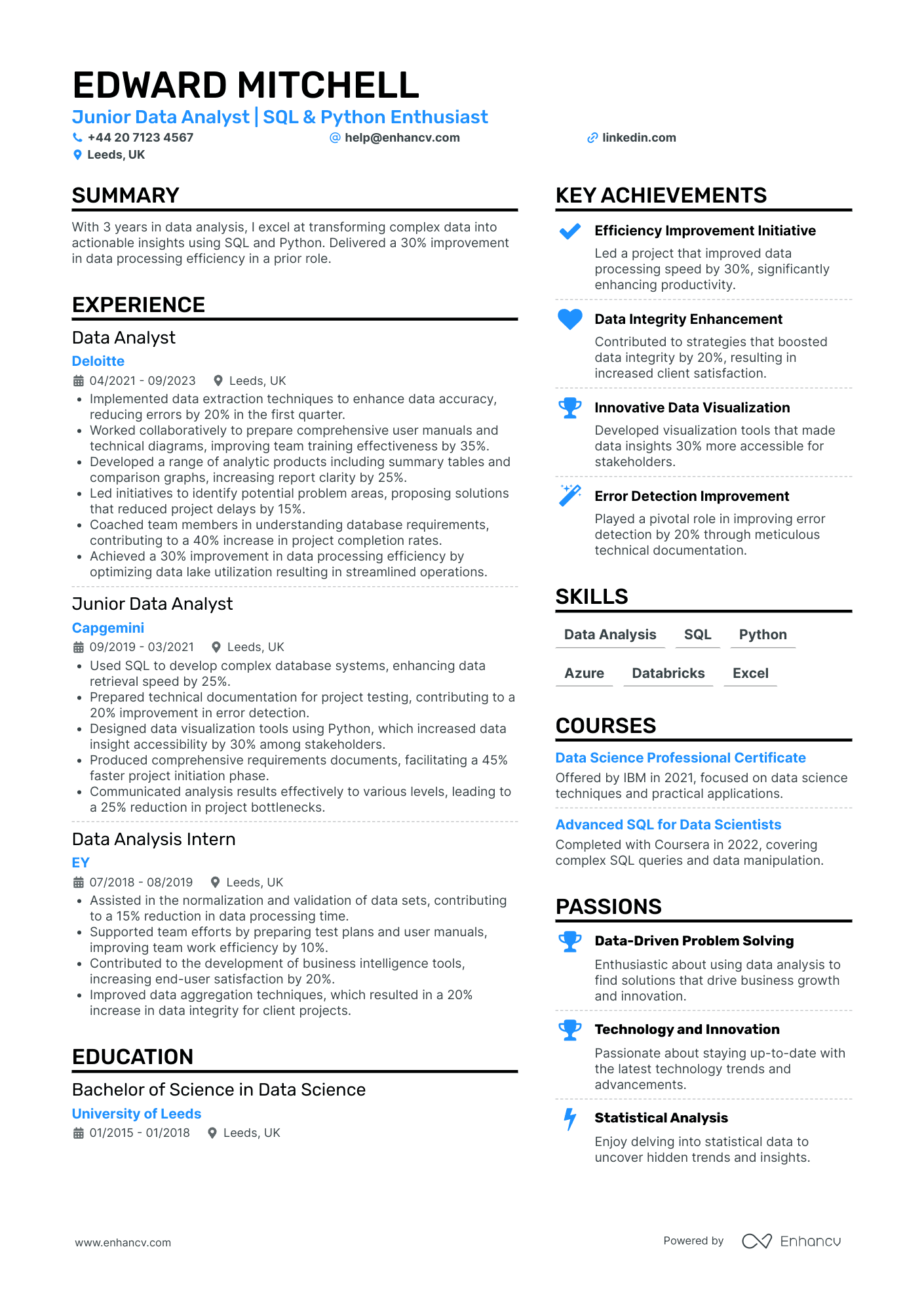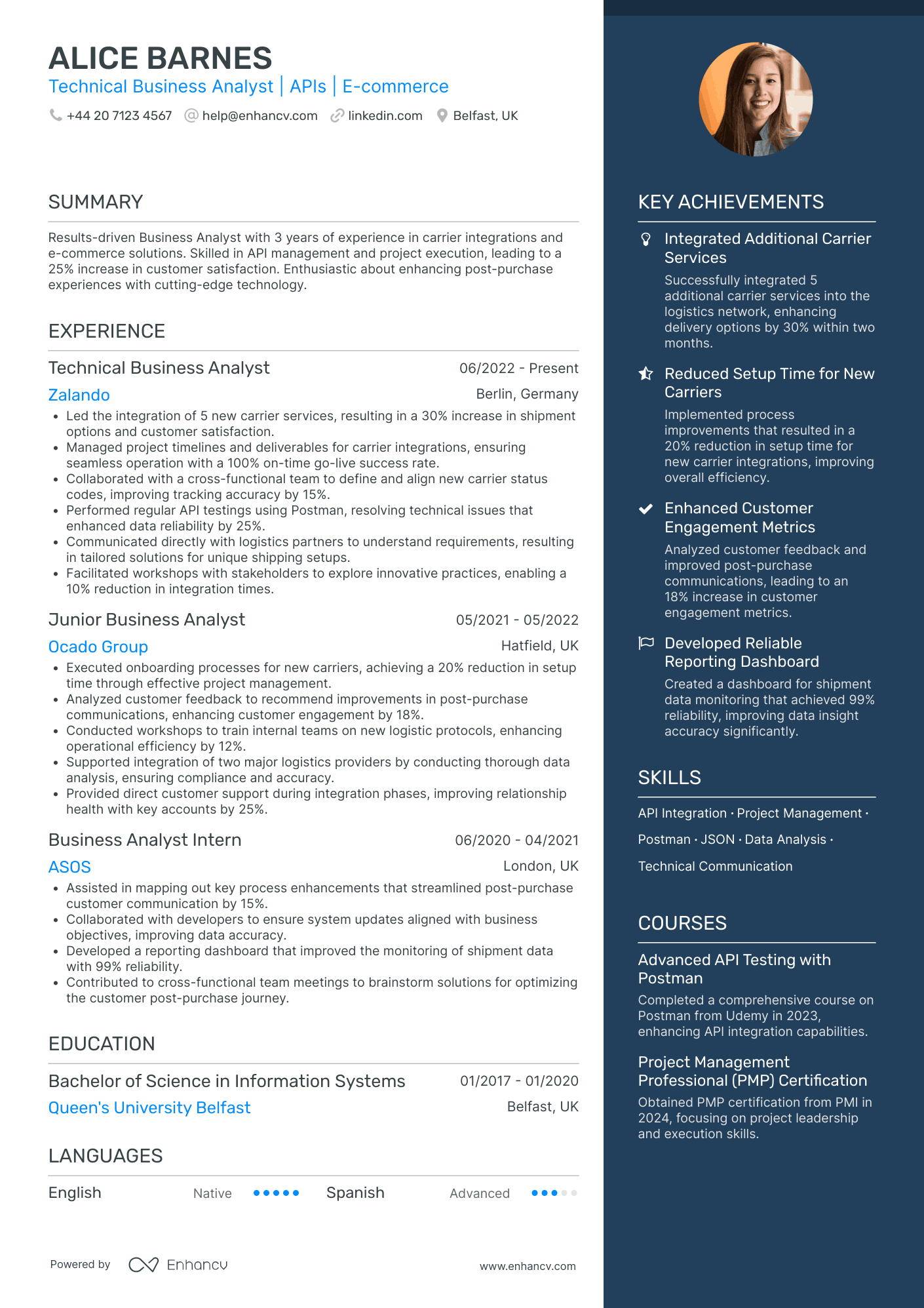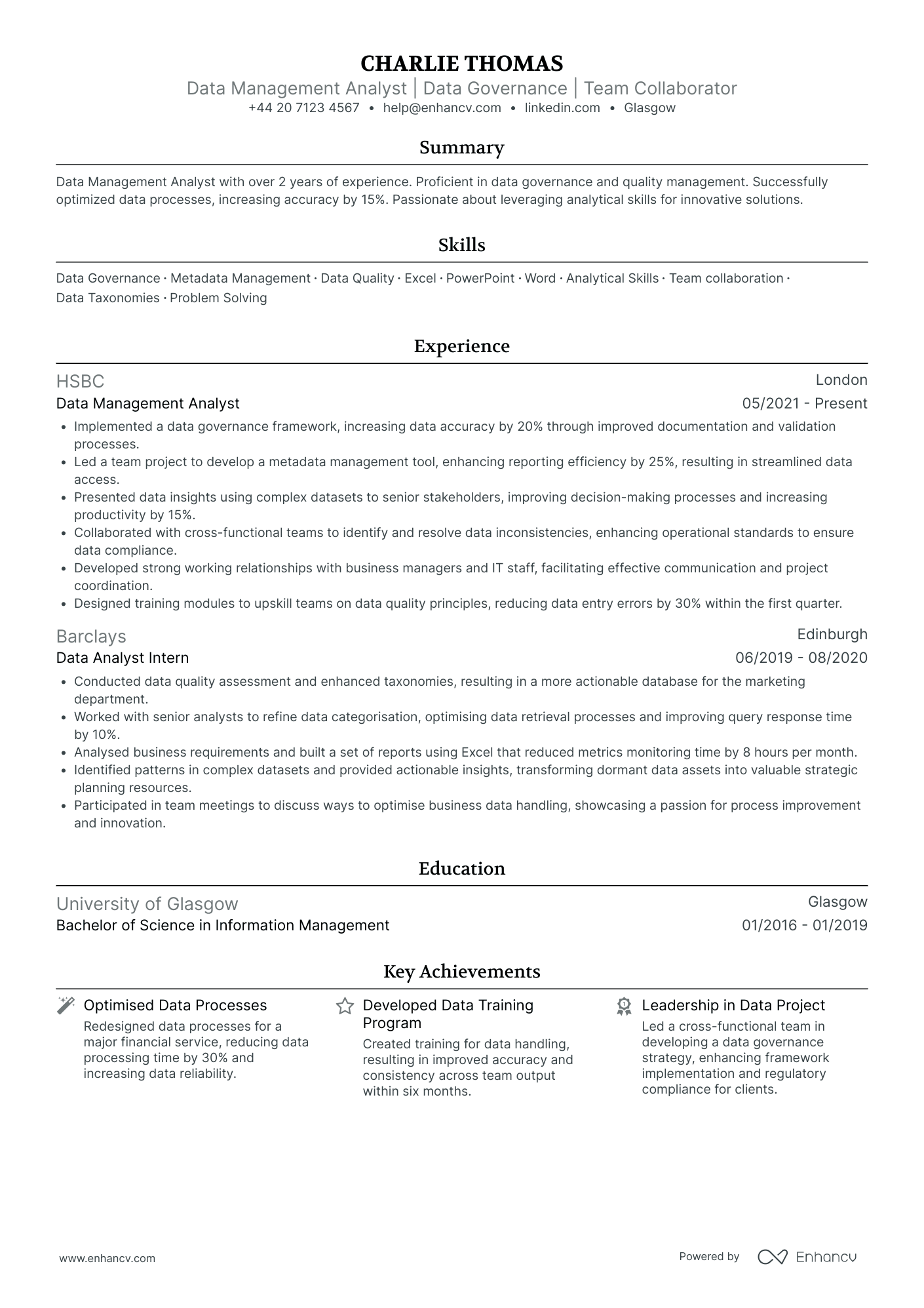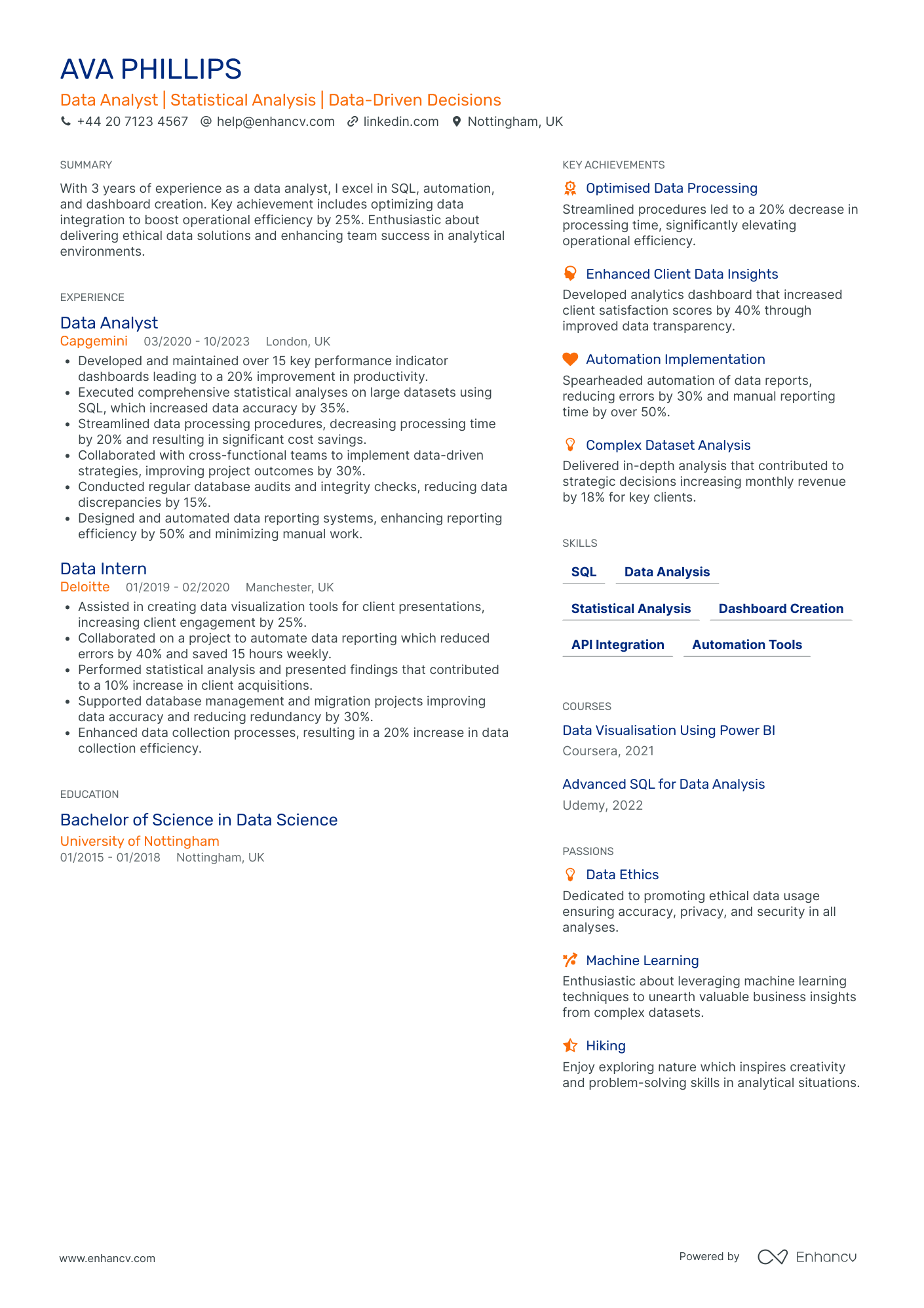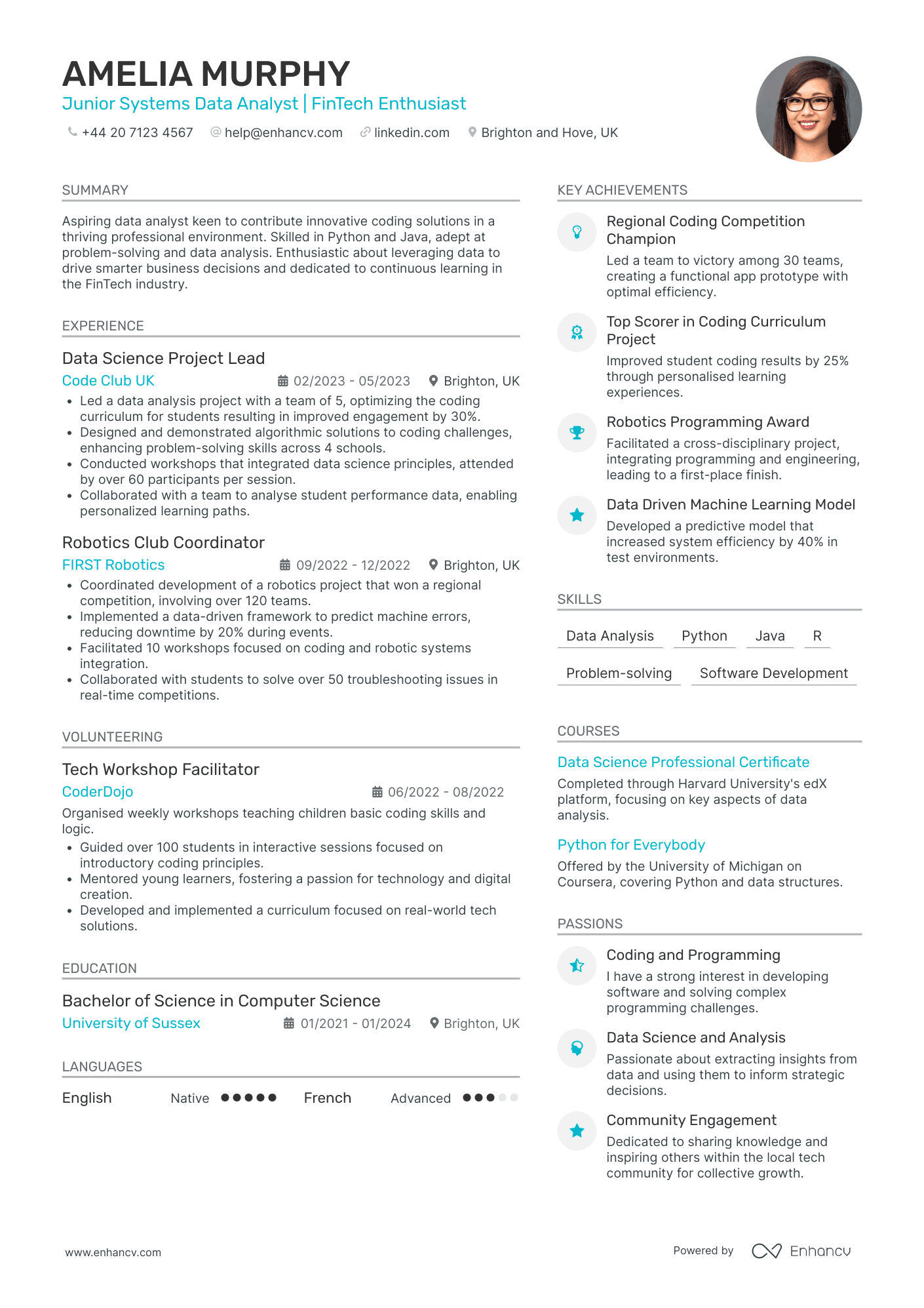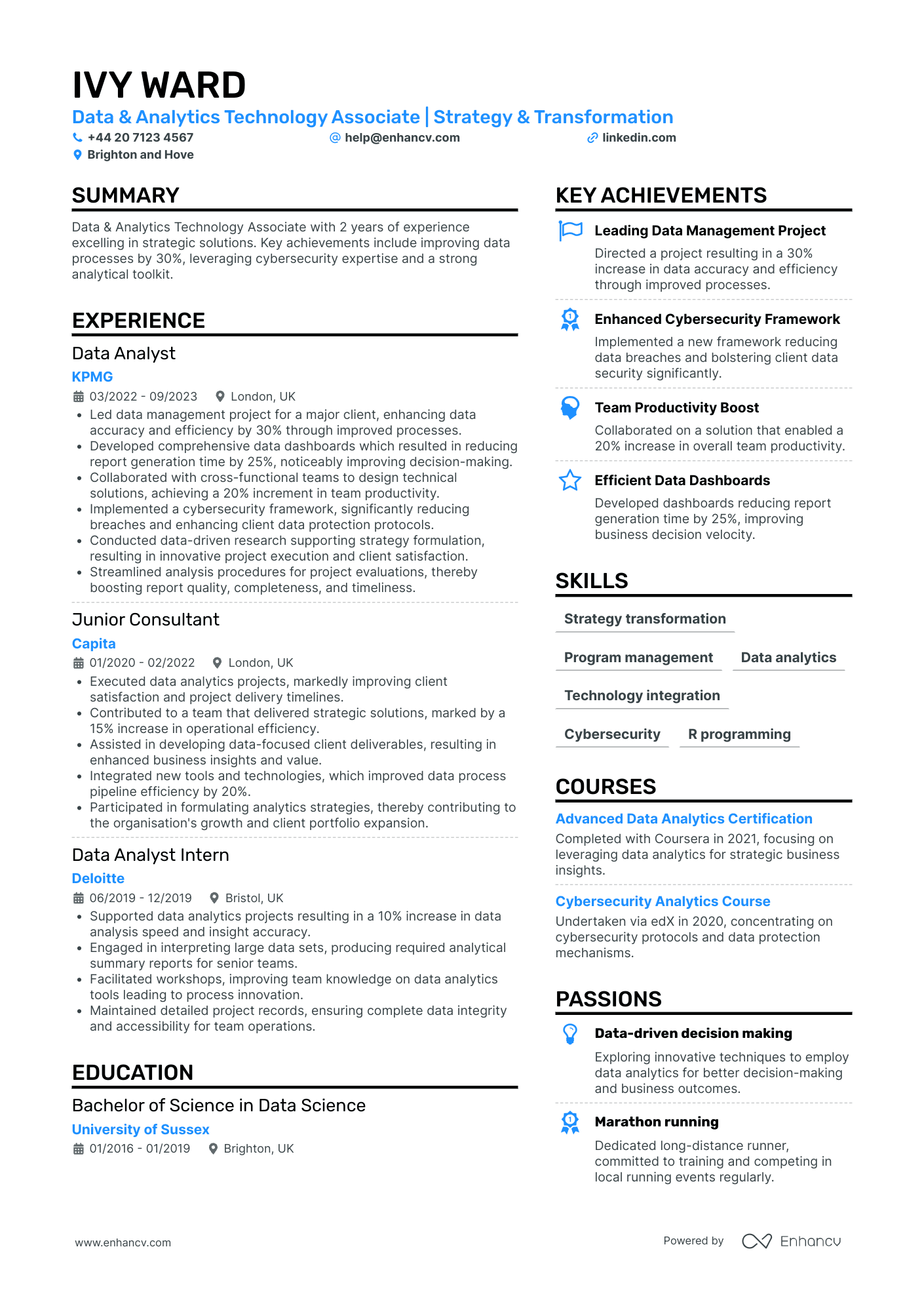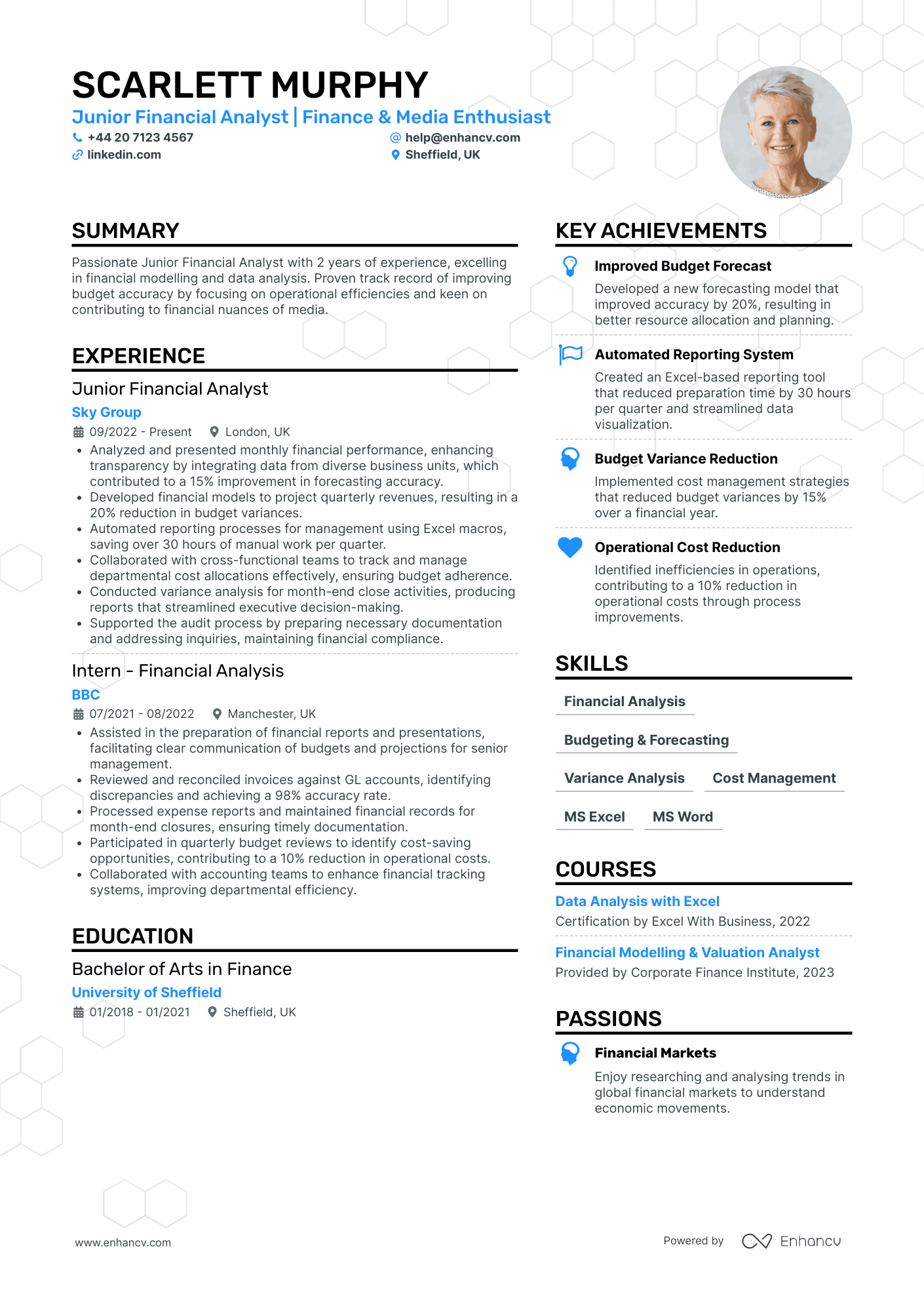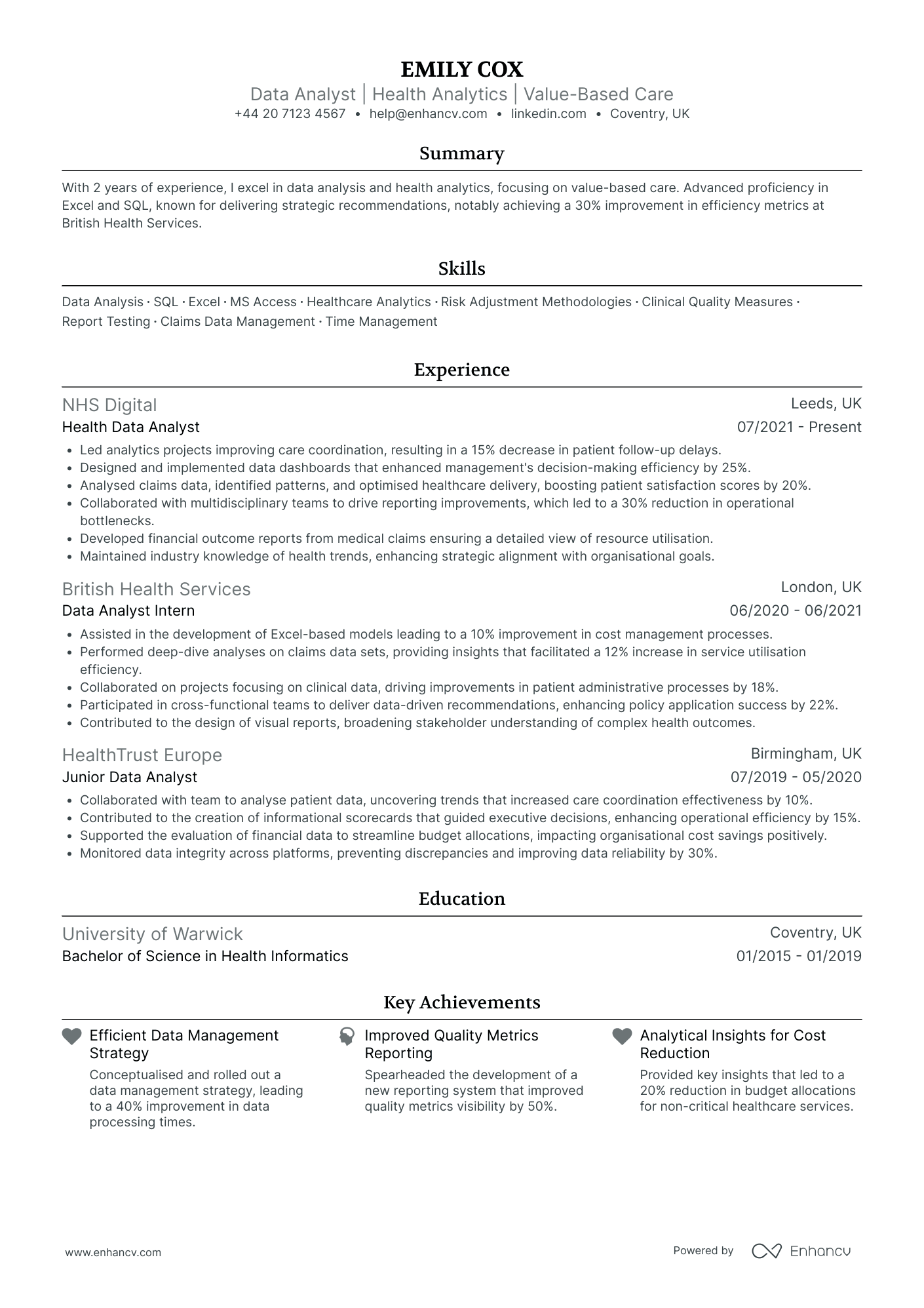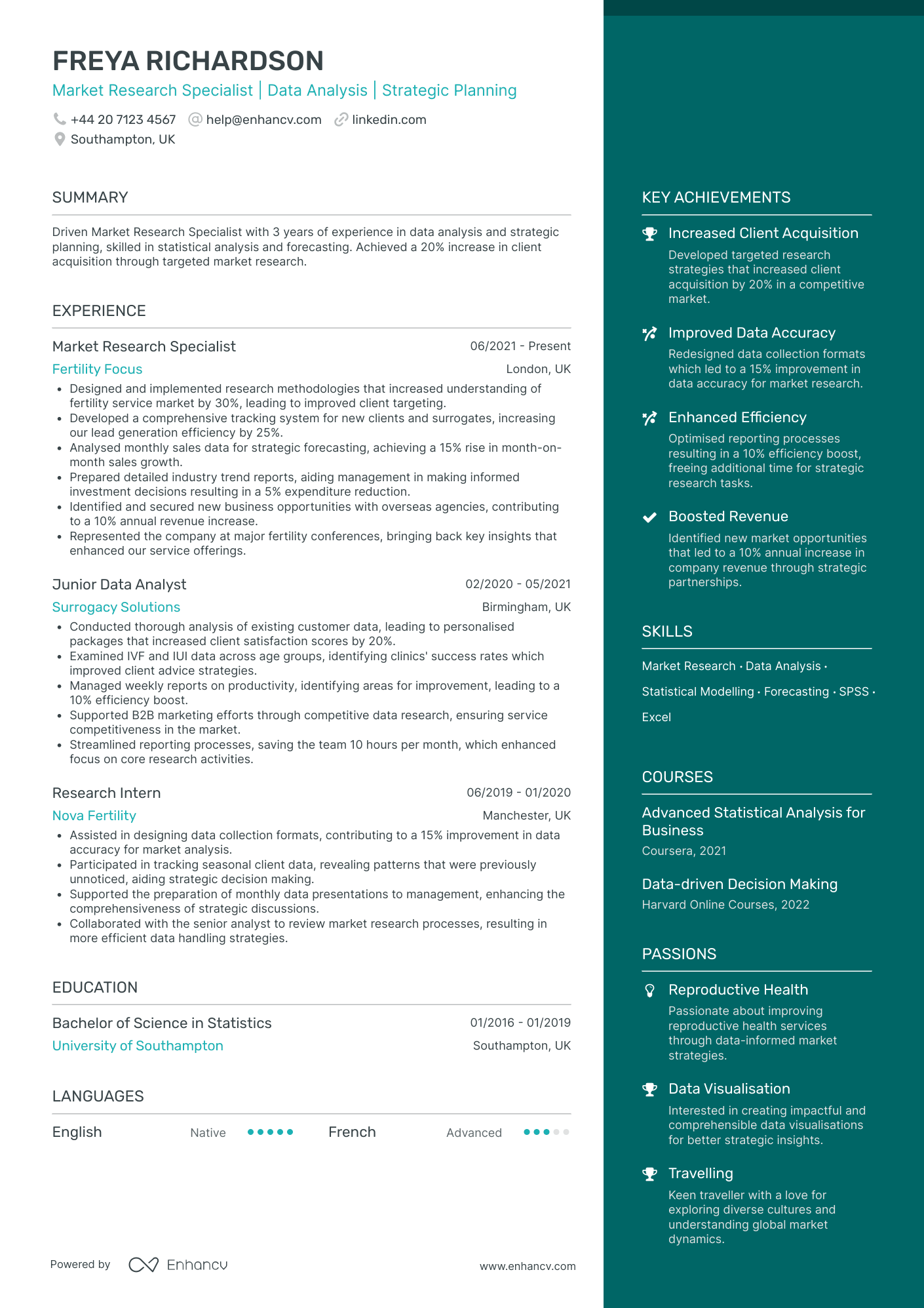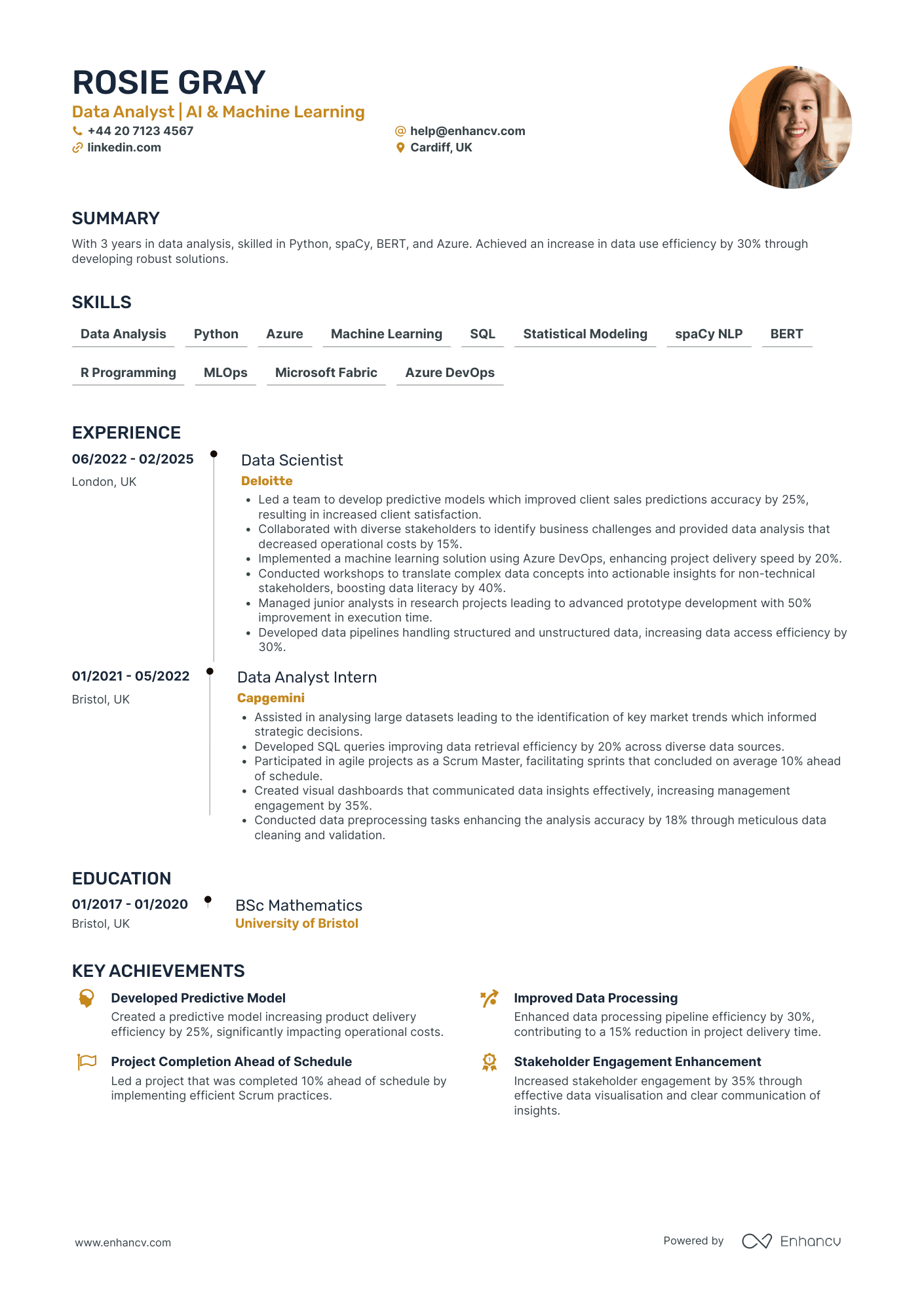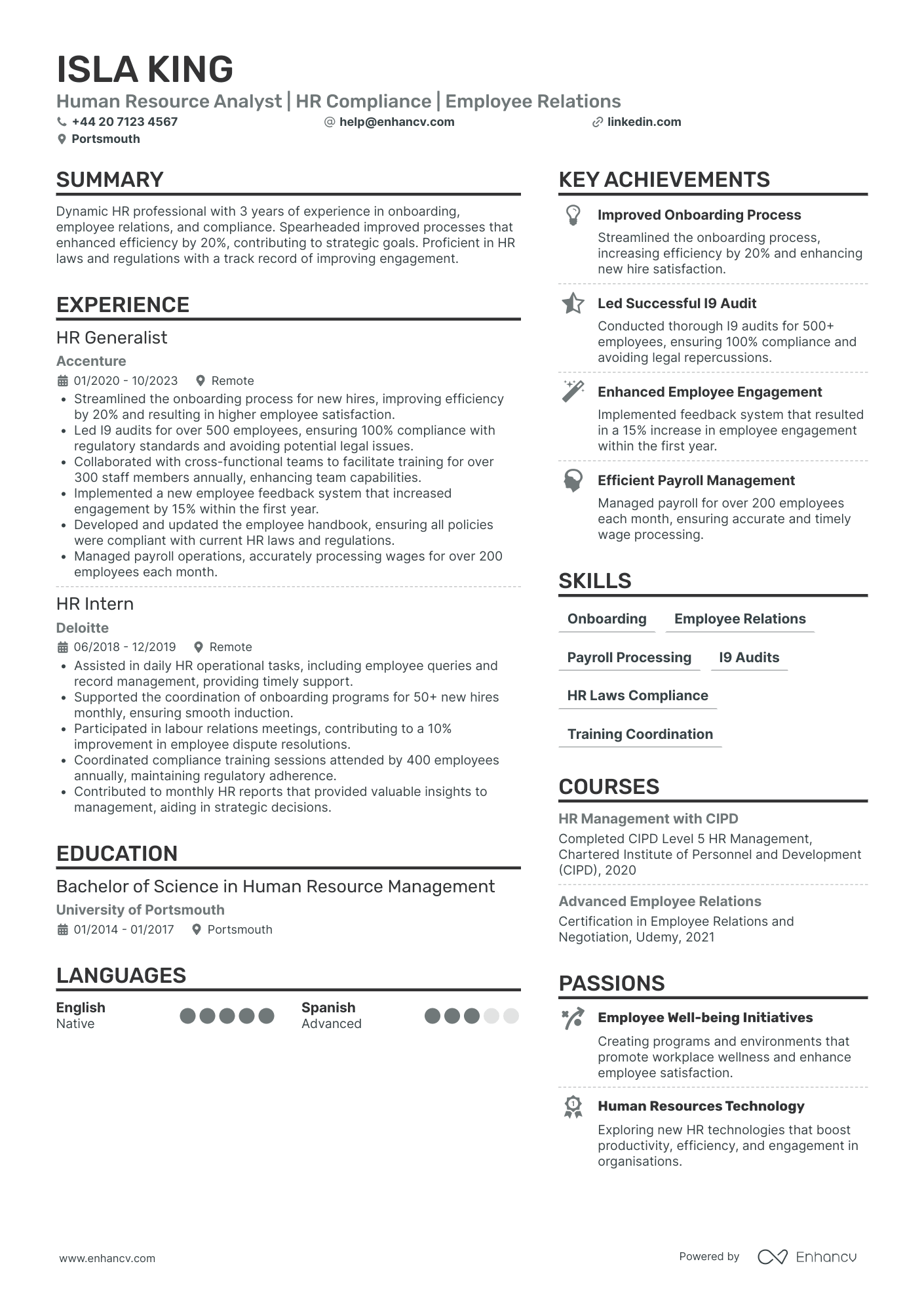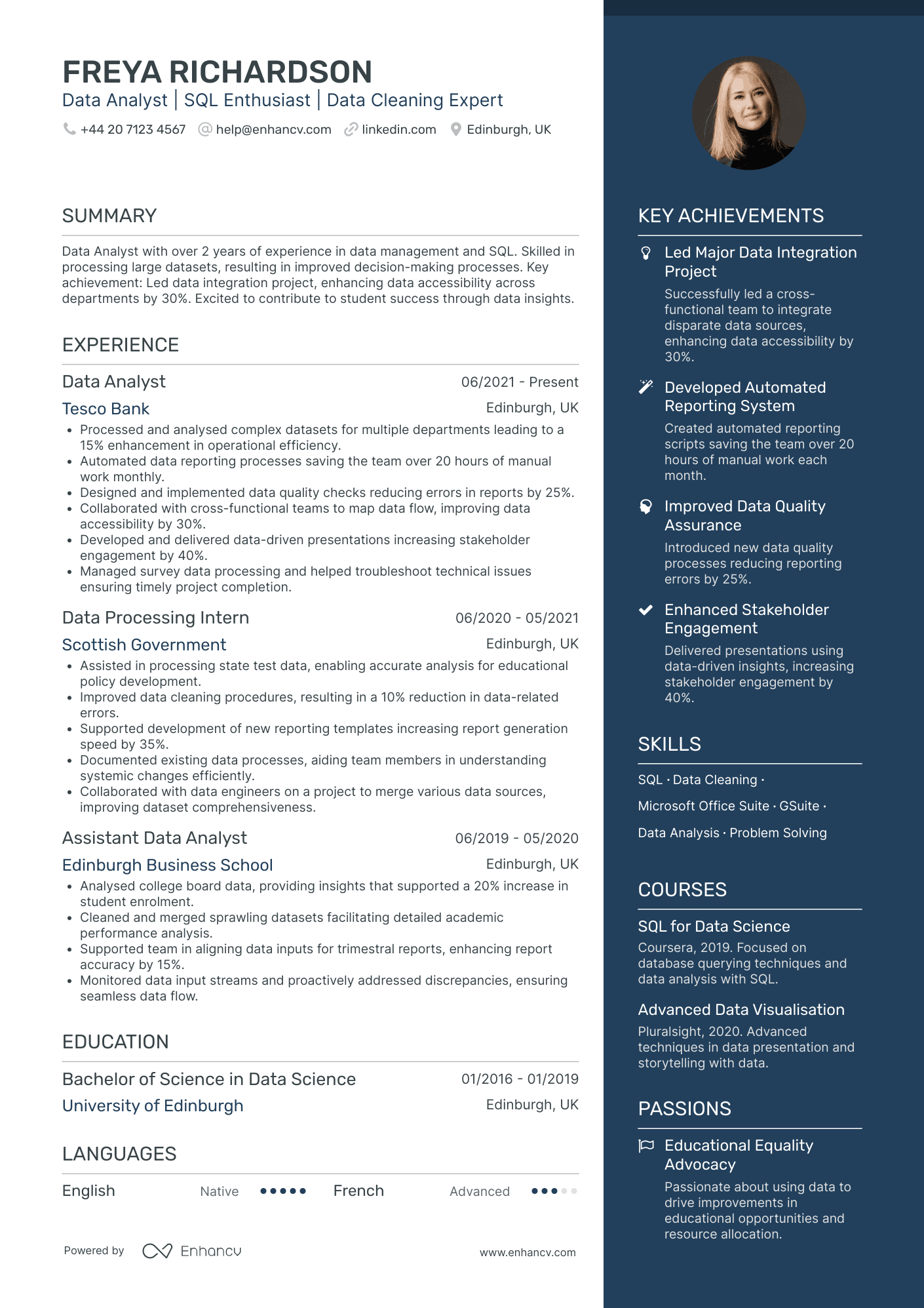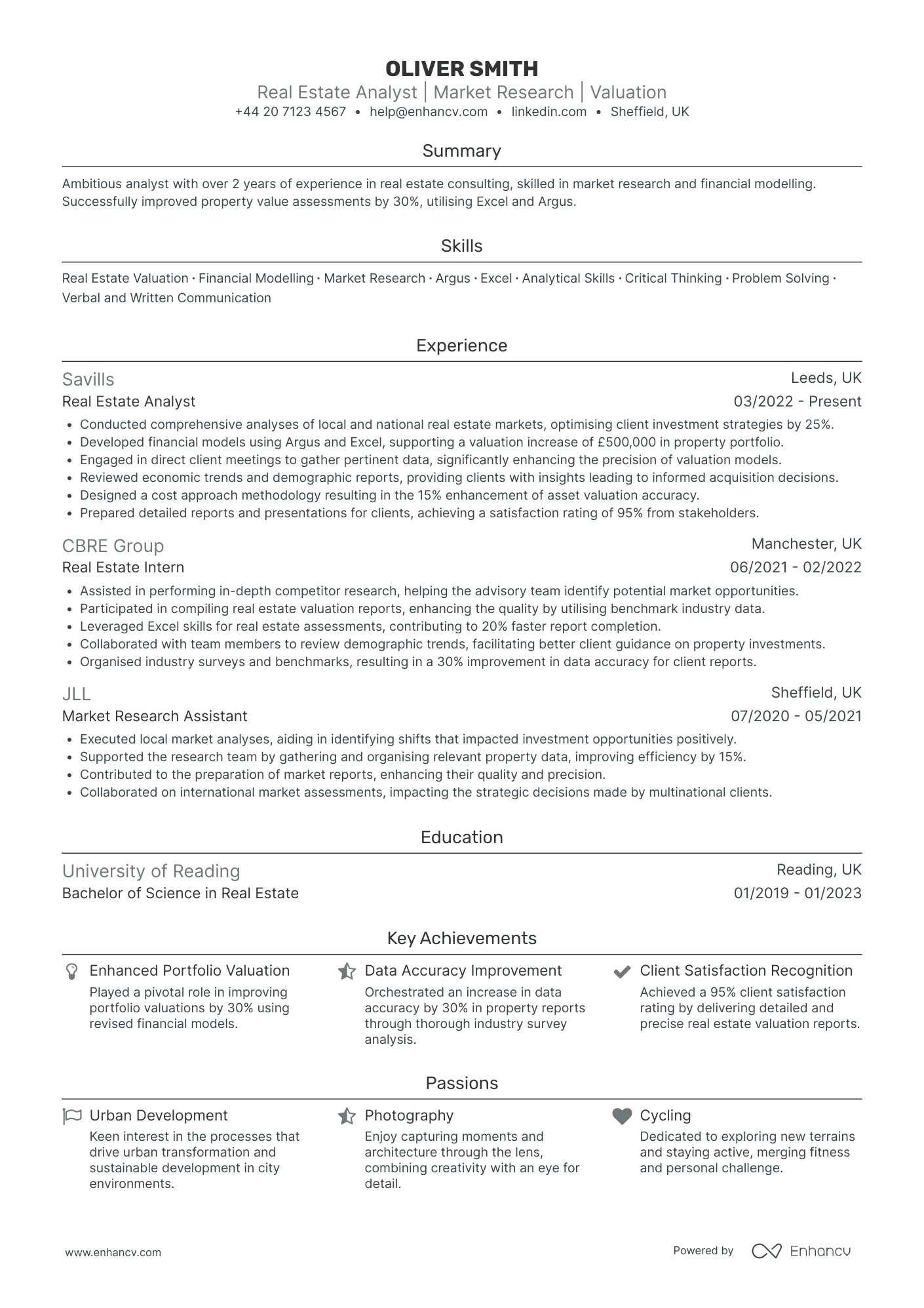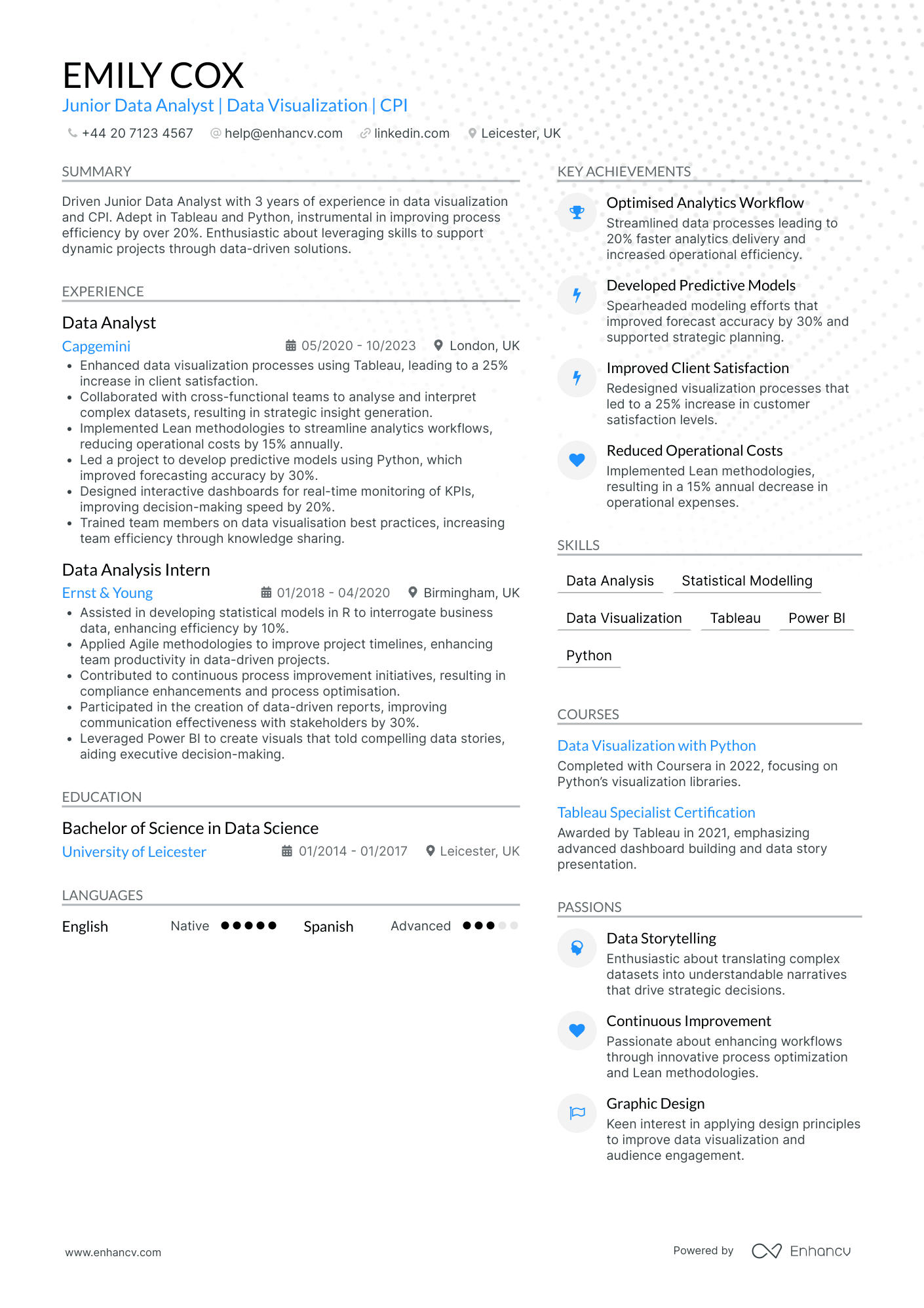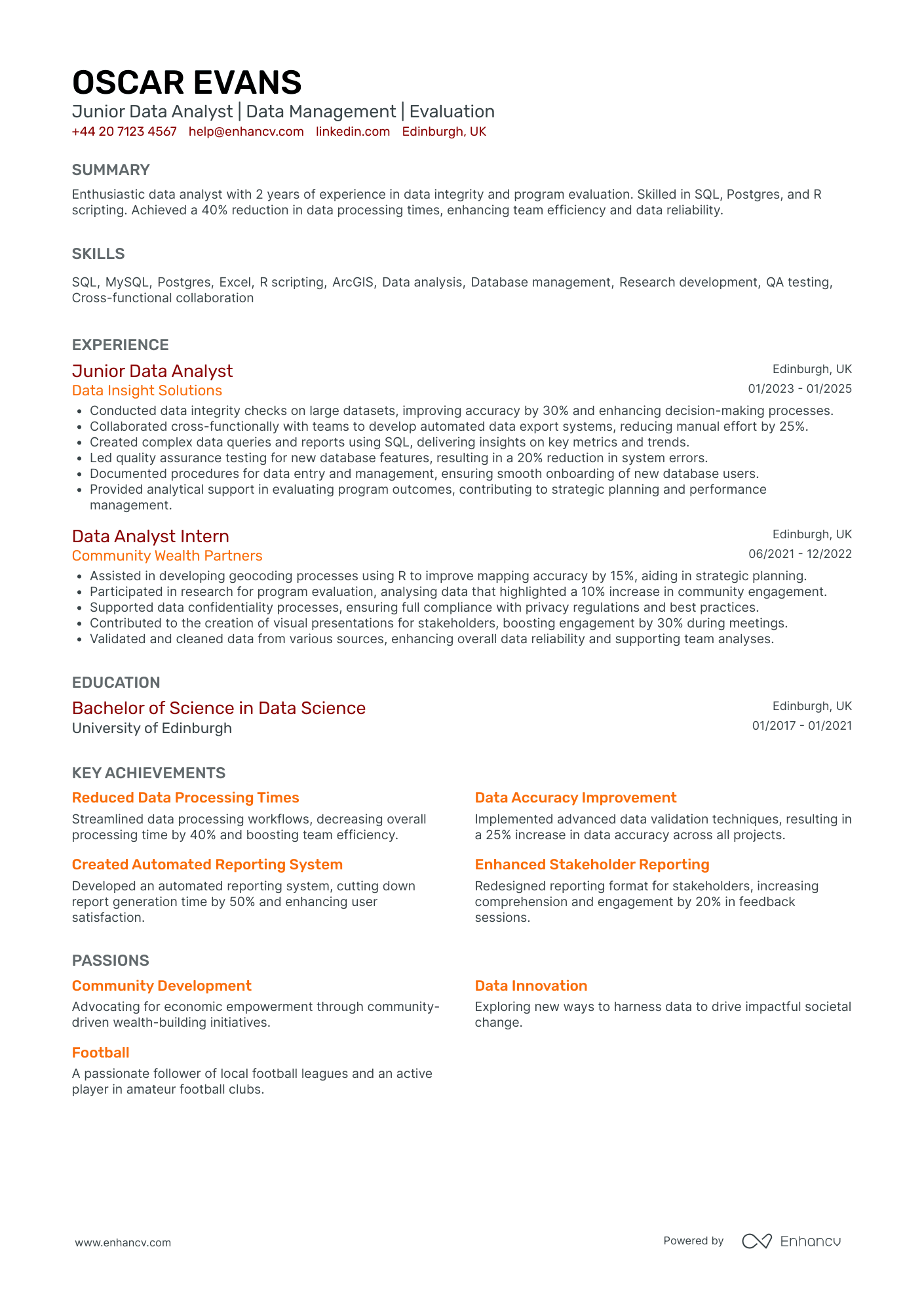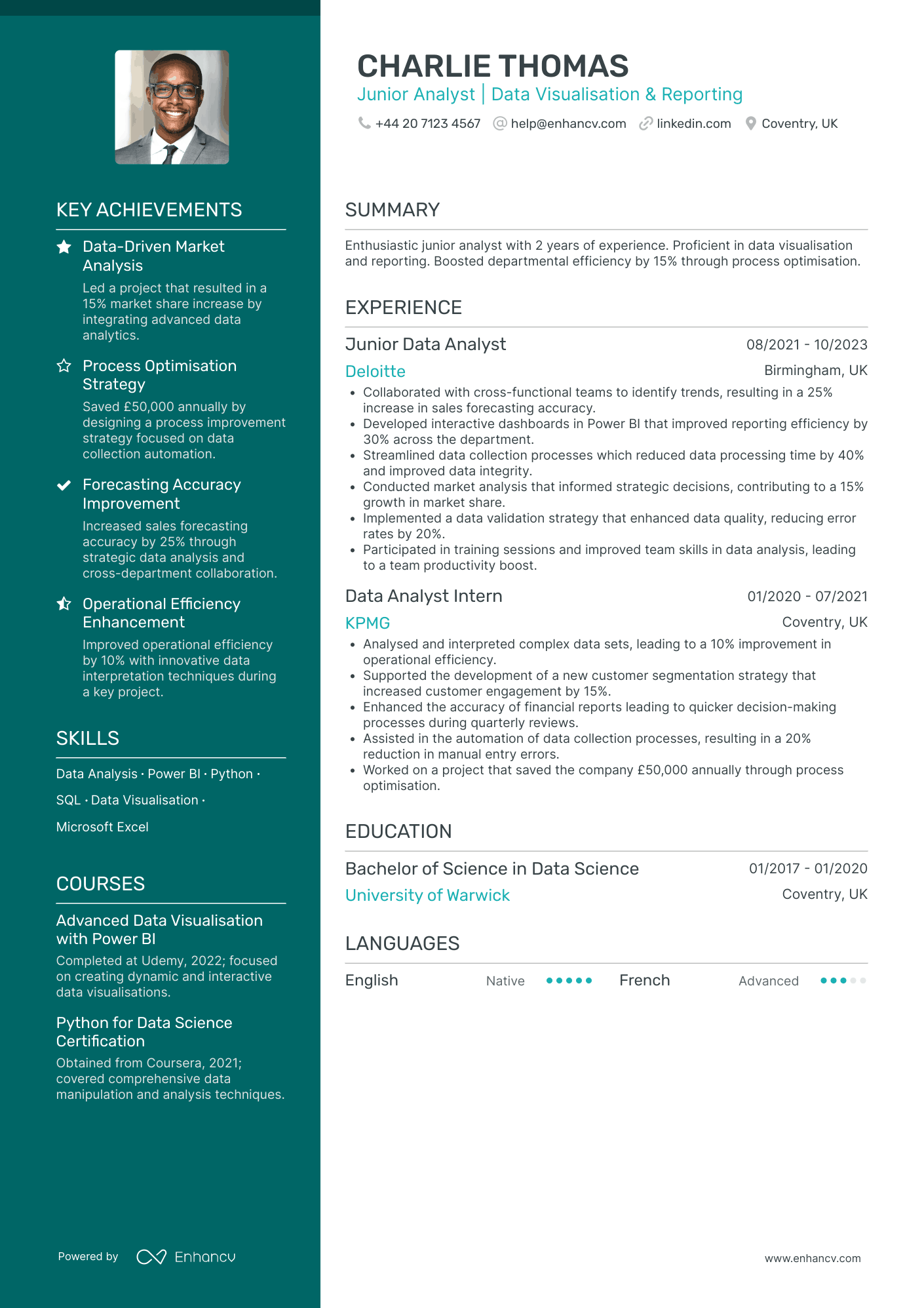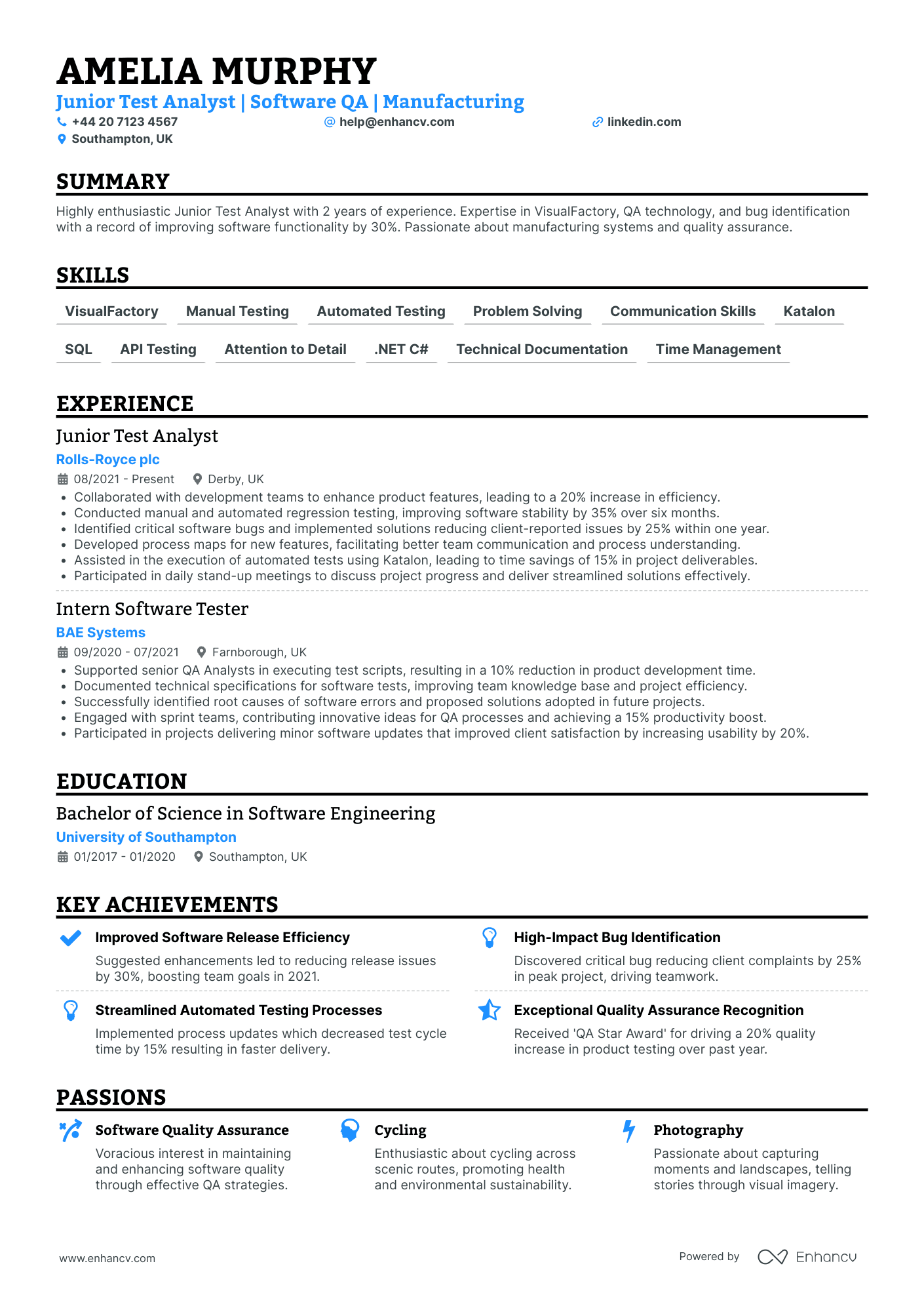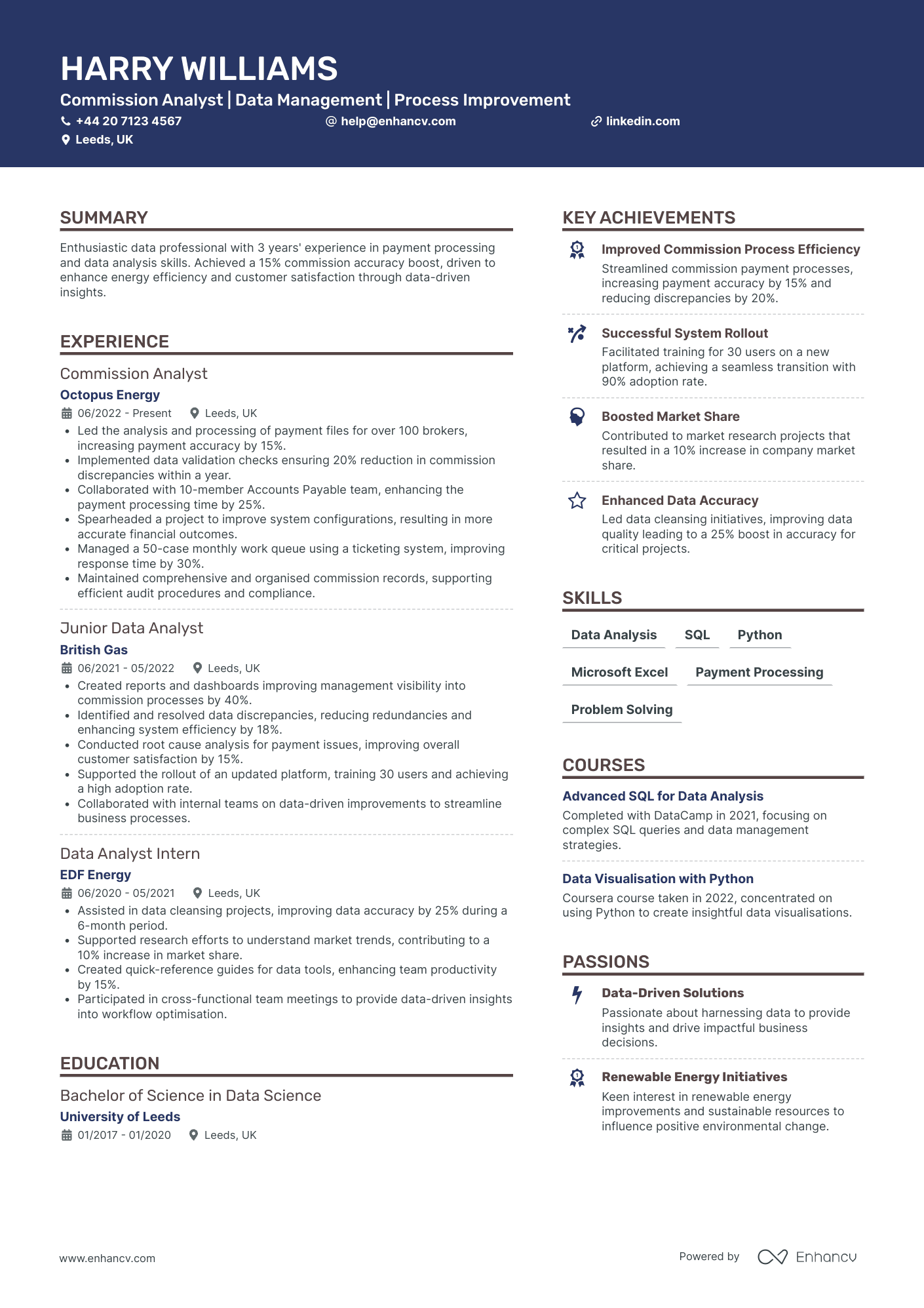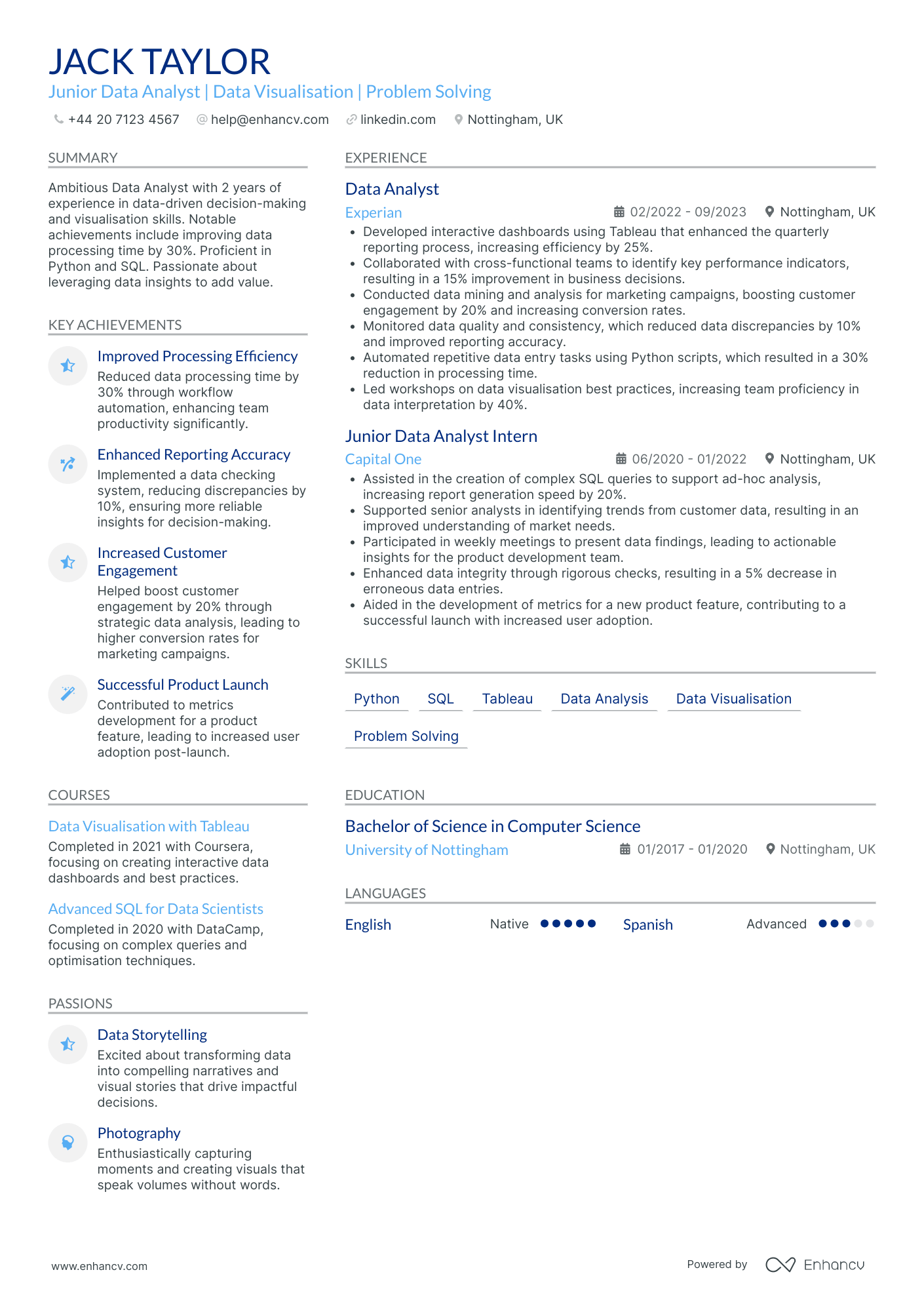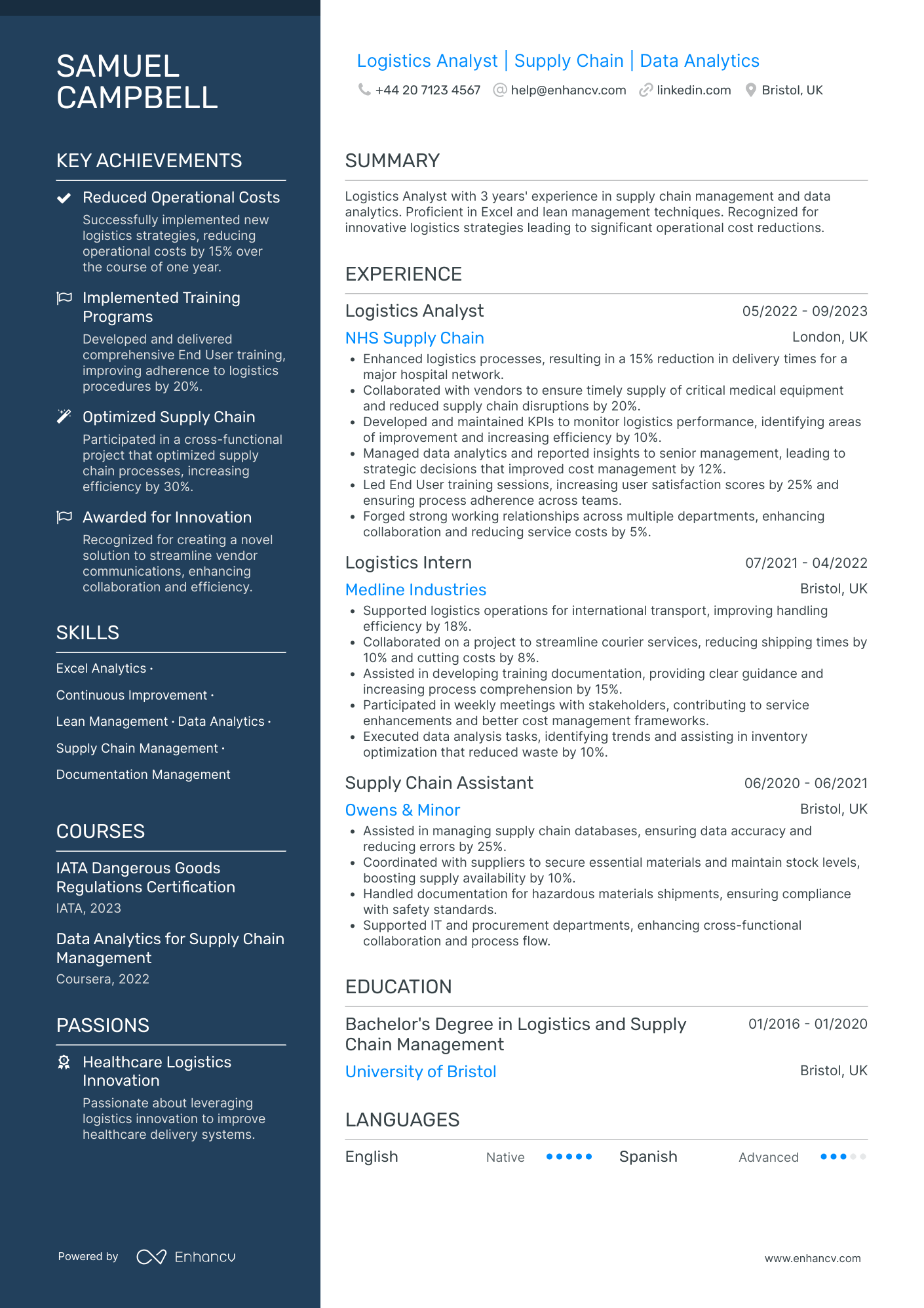Acquiring relevant experience can be particularly challenging for a junior data analyst when competing in the job market. Our guide will provide you with practical steps to enhance your CV and showcase your analytical prowess, even with limited professional experience.
- Applying best practices from real-world examples to ensure your profile always meets recruiters' expectations;
- What to include in your work experience section, apart from your past roles and responsibilities?
- Why are both hard and soft skills important for your application?
- How do you need to format your CV to pass the Applicant Tracker Software (ATS) assessment?
If you're writing your CV for a niche junior data analyst role, make sure to get some inspiration from professionals:
Resume examples for junior data analyst
By Experience
Entry-Level Junior Data Analyst
- Structured and Concise Presentation - The CV is well-organized with distinct sections that make it easy to navigate. This clarity is evident as each section concisely presents relevant information, allowing the reader to quickly grasp Edward's background, skills, and achievements without being overwhelmed by excessive details.
- Progressive Career Trajectory - Edward's career path showcases clear progression from a Data Analysis Intern to a Junior and then a Data Analyst role. This trajectory highlights his growing expertise and increased responsibility over time, reflecting a strong commitment to personal and professional development within the analytics field.
- Impactful Achievements with Business Relevance - The CV effectively emphasizes the tangible business impact of Edward's work, with achievements like a 30% improvement in data processing speed and a 25% reduction in project bottlenecks. These metrics demonstrate not only technical proficiency but also a clear understanding of how to drive business efficiency and success through data analysis.
Intermediate Junior Data Analyst
- Structured and Clear Presentation - The CV is excellently organized, with concise sections that facilitate easy navigation through Alice Barnes' professional journey. It efficiently presents her qualifications and career timeline while maintaining clarity in each experience, making it approachable for recruiters to assess her capabilities swiftly.
- Progressive Career Development - Alice's career trajectory shows clear growth, moving from an intern position to a Technical Business Analyst at notable companies like ASOS, Ocado Group, and Zalando. This progression signifies her increasing responsibility and depth of expertise in business analysis, particularly focusing on e-commerce and carrier integrations.
- Demonstrated Impact on Business Goals - The CV highlights achievements in a meaningful way, not just through numbers but by relating those numbers to business outcomes. For example, it connects a 30% increase in shipment options directly to improved customer satisfaction, demonstrating Alice’s ability to effectively link her technical skills to tangible business benefits.
Advanced Junior Data Analyst
- Emphasis on Data Governance and Quality Management - The CV clearly showcases the candidate's specialization in data governance and quality management. It highlights their proficiency by detailing specific achievements, such as developing a data governance framework and reducing data processing time by 30%, evidencing their impact on operational standards and data integrity.
- Progressive Career Path with Recognized Companies - Charlie Thomas's career trajectory displays a solid upward movement, with roles in esteemed financial institutions like HSBC and Barclays. This progression not only reflects growing responsibilities but also the ability to adapt and excel in high-pressure environments, serving as a testament to their competence in data management roles.
- Project Leadership and Cross-Functional Collaboration - The CV underscores effective leadership skills through instances where Charlie led teams to success, notably in metadata management and developing a data governance strategy. Their capacity for cross-functional teamwork is a recurring theme, highlighting the ability to work seamlessly with diverse teams to optimize data processes and compliance.
Junior Data Analyst Trainee
- Effective Use of Quantifiable Achievements - Ava Phillips' CV effectively highlights her impact in measurable terms, such as optimizing data integration to boost operational efficiency by 25%. This approach not only demonstrates her skills but also her contributions to improving business outcomes, making her achievements relevant and impactful.
- Strong Emphasis on Cross-Functional Collaboration - Ava's experience reflects her adeptness in collaborating with cross-functional teams, which is crucial in her field. Her efforts to implement data-driven strategies that improved project outcomes by 30% underline her capability to work effectively across various departments for maximum impact.
- Comprehensive Skill Set in Data Analysis and Automation - The CV outlines a broad and deep technical proficiency, listing skills such as SQL, Python, R, and automation tools. This depth in data analysis tools and methodologies demonstrates Ava's ability to tackle complex problems and drive efficiency through technical expertise.
Junior Data Analyst Intern
- Clear and Dynamic Structure - The CV is well-organized, offering a smooth flow of information from the candidate's professional summary to detailed sections on skills, education, and experience. Each section clearly communicates its purpose, making it easy for employers to identify key qualifications and achievements.
- Evidence of Rapid Career Development - Amelia's career trajectory demonstrates swift progression, from leading a data science project at Code Club UK to coordinating a robotics club. This showcases rapid skill acquisition and ambition, valuable traits for advancement in the evolving tech industry.
- Integration of Technical and Interpersonal Skills - While the CV details extensive technical competencies in data analysis and programming, it equally emphasizes Amelia’s leadership and collaboration through roles that required managing teams and fostering student engagement, highlighting her as a well-rounded candidate.
Junior Data Analyst Associate
- Clear and Structured Content Presentation - The CV is presented with clarity and concise structuring, making it easy to navigate. Each section, from work experience to skills and education, is organized in a way that highlights key achievements and responsibilities without overwhelming the reader with too much detail in any one area.
- Impressive Career Trajectory - Ivy Ward's career shows a clear trajectory of growth, moving from a Data Analyst Intern to a Data Analyst and then a Junior Consultant, ultimately leading to the role of a Data & Analytics Technology Associate. This progression indicates a strong foundation in data analytics and strategic transformation within reputable companies like Deloitte, Capita, and KPMG.
- Proficiency in Industry-Specific Tools and Methodologies - The CV highlights proficiency in specialized tools and methodologies critical to the data analytics field, such as R programming, SQL, and machine learning. This technical depth is complemented by certifications in advanced data analytics and cybersecurity, demonstrating Ivy's commitment to staying updated with industry advancements.
By Industry
Junior Data Analyst in Financial Services
- Clear and Functional Structure - The CV is well-organized, presenting a coherent flow from the header to the detailed breakdown of professional experiences and education. This logical structure makes it easy for potential employers to navigate through her credentials, instantly focusing on relevant areas such as experience in financial analysis and skillset, which align well with her current role as Junior Financial Analyst.
- Career Growth within Financial Sector - Scarlett Murphy's career trajectory demonstrates a focused progression within the financial sector, starting as an intern at the BBC and advancing to a role at the Sky Group. This advancement highlights her dedication and growing expertise in financial analytics, suggesting she is well-adapted in scaling her responsibilities and leveraging her experience to refine her professional skills.
- Adaptability with Cross-Functional Collaboration - Her CV emphasizes experience in collaborating with cross-functional teams, which is crucial for financial analysts working within diverse business environments. This experience underscores her adaptability and capability to work seamlessly across various departments, fostering improved communication and operational efficiency, which is essential for enhancing budget accuracy and mitigating financial discrepancies.
Junior Data Analyst in Healthcare
- Comprehensive career progression - Emily Cox's CV clearly outlines a steady career trajectory, demonstrating growth from a Data Analyst Intern to Health Data Analyst. Her experience in reputable organizations like NHS Digital reflects both upward mobility and a deepening of expertise in healthcare analytics.
- Emphasis on technical competencies - The CV is enriched with industry-specific tools and methodologies, such as SQL, Excel, Healthcare Analytics, and Claims Data Management. This indicates a strong technical foundation necessary for data-driven decision-making in the health sector.
- Significant and relevant achievements - Emily's achievements are not just numbers but clearly underline her impact within the healthcare sector. Metrics like a 30% reduction in operational bottlenecks and a 20% boost in patient satisfaction scores exemplify her ability to drive meaningful change and improvement in healthcare services.
Junior Data Analyst in Marketing
- Strong Career Progression in Market Research - Freya's CV highlights a well-defined career trajectory from a Research Intern to a Market Research Specialist, demonstrating consistent growth and adaptation within the reproductive health sector. Each role exhibits a clear progression in responsibilities and achievements, reflecting her commitment to advancing in market research and data analysis fields.
- Blend of Technical Proficiency and Soft Skills - The document illustrates Freya's expert use of industry-standard tools like SPSS and Excel for data analysis, alongside soft skills such as strategic planning and report writing, crucial for effective market research. This combination underscores her ability to not only gather and analyze data but also to communicate insights compellingly.
- Achievements with Tangible Business Impact - The CV effectively presents Freya's accomplishments in a business context by detailing the impact of her strategies, such as enhancing lead generation efficiency by 25% and increasing client acquisition by 20%. These metrics emphasize her ability to drive significant improvements in business performance through targeted market research.
Junior Data Analyst in Retail
- Comprehensive Utilization of Advanced Tools and Technologies - Rosie Gray’s CV illustrates a strong command of specialized tools such as spaCy, BERT, and Azure DevOps, emphasizing her expertise in cutting-edge AI and machine learning methodologies. Her proficiency in these technologies indicates not only technical depth but also a commitment to staying abreast of industry advancements, making her an asset in data-driven environments.
- Progressive Career Trajectory Highlighting Leadership Growth - Beginning as an intern at Capgemini and advancing to a Data Scientist at Deloitte, Rosie's career progression reflects significant growth in her responsibilities. Her ascension from supporting roles to leading teams and managing junior analysts demonstrates a clear path of increasing leadership and influence within her field.
- Highlighted Achievements with Clear Business Impact - The CV presents Rosie's achievements in a manner that ties directly to business outcomes, such as improving client sales predictions, reducing operational costs, and enhancing project delivery speed. This focus on impact, rather than just processes or tasks, underscores her ability to drive meaningful results and contribute to the organization's success.
Junior Data Analyst in Logistics
- Structured and Concise Content Presentation - The CV stands out with its well-organized structure, employing clear headings and bullet points that enhance readability. Each section is concise yet detailed, allowing quick comprehension of the candidate's skills and experiences.
- Progressive Career Trajectory - Samuel Campbell's career progression reflects deliberate growth from a Logistics Intern to a Logistics Analyst within a few years. This trajectory highlights his ambitious nature and ability to advance within competitive environments, especially in the logistics and supply chain sectors.
- Impactful Achievements in Logistics and Supply Chain - By showcasing quantified achievements, such as reducing delivery times by 15% and improving cost management by 12%, the CV emphasizes significant contributions to organizational efficiency. Such achievements not only exemplify skill but also underline the tangible business impacts Samuel has imparted through his professional endeavors.
Junior Data Analyst in Human Resources
- Structured and Concise Content Presentation - The CV is well-organized, presenting each section clearly with concise bullet points that emphasize key achievements and responsibilities. This clarity allows recruiters to quickly grasp Isla King's qualifications and fit for the HR Analyst role.
- Consistent Career Growth in HR Field - Progressing from an HR Intern to an HR Generalist at renowned firms such as Deloitte and Accenture, Isla's career trajectory demonstrates steady advancement and commitment to the HR sector. This progression suggests strong career development and increasing responsibility over time.
- Impactful Achievements with Business Relevance - The CV highlights achievements, such as improving onboarding efficiency and leading I9 audits, which have direct business implications. These accomplishments do not merely reflect numerical improvements but also ensure compliance and enhance employee satisfaction, proving Isla's contributions to organizational goals.
Junior Data Analyst in IT
- Content is concise and structured - Freya’s CV presents information in a well-organized, clear format, making it easy to identify key experiences and qualifications. Each section is labeled appropriately, guiding the reviewer smoothly through her career details and achievements.
- Highlights consistent career growth and specialization - Freya's career trajectory shows a clear progression from internships to becoming a data analyst with leadership in major projects. There’s evident growth through the increasing complexity and impact of her projects, especially in her role with Tesco Bank, where she led a significant data integration project.
- Demonstrates technical expertise and tool proficiency - The CV emphasizes Freya’s strong grasp over SQL, data cleaning, and reporting tools, essential skills for a data analyst. Her proficiency in database querying techniques and advanced data visualization showcases her depth in handling technical challenges within the industry.
Junior Data Analyst in Real Estate
- Content presentation with structured clarity - The CV presents information in a clear and concise manner, utilizing well-defined sections that facilitate easy navigation through career highlights, skills, and achievements. Each experience bullet point is crafted for brevity and impact, ensuring the reader grasps the key contributions and expertise areas swiftly.
- Promising trajectory through roles and responsibilities - Oliver's career progression reflects a strong growth pattern, moving from a Market Research Assistant role to a Real Estate Analyst position. The transition showcases an increasing scope of responsibilities and impact in the industry, indicating a deepening engagement with real estate analytics and valuation.
- Proven methodologies and technical expertise - The CV emphasizes the candidate's proficiency with industry-specific tools such as Argus and Excel, highlighting the ability to enhance property valuation accuracy and complete reports efficiently. This not only illustrates technical depth but also a commitment to leveraging the latest software for optimal results.
Junior Data Analyst in Non-profit
- Clear and Concise Content Presentation - The CV is well-organized with distinct sections that enhance readability and coherence. Each section is concisely presented, allowing easy navigation and understanding of Emily's qualifications and experiences.
- Relevant and Impactful Achievements - Emily’s CV highlights achievements with direct business relevance, illustrating her success in enhancing operational efficiency, client satisfaction, and predictive accuracy, thus showcasing her value to potential employers.
- Diverse Technical Skill Set - The CV reflects Emily’s deep technical expertise, evidenced by her proficiency in industry-standard tools like Tableau, Python, and Power BI, as well as her understanding of key methodologies such as Lean and Agile, making her a strong candidate in the data analysis field.
Junior Data Analyst in Education
- Engages with clear structure and concise information - The CV's presentation stands out with its organized sections that make it easy to navigate through key details such as experience, education, and skills. Each section provides concise yet comprehensive information, allowing potential employers to quickly grasp the candidate's core competencies and career history.
- Strong focus on technical expertise in data management - Oscar Evans’ CV highlights a strong command of industry-specific tools such as SQL, Postgres, and R scripting. This emphasis on technical depth demonstrates a well-grounded ability to manage and analyze complex datasets, which is essential for a data analytical role and presents a thorough understanding of database management systems.
- Achievements demonstrate business impact and efficiency improvements - The CV details specific achievements that not only include impressive numerical improvements but also emphasize their impact on business processes. For instance, a 40% reduction in data processing times significantly boosts operational efficiency, while a 25% increase in data accuracy enhances decision-making reliability, showcasing the candidate's ability to contribute meaningfully to organizational goals.
Junior Data Analyst in Telecommunications
- Comprehensive and structured content presentation - The CV is well-organized, featuring clear sections that guide the reader through the applicant’s qualifications, including a concise summary that immediately communicates key strengths in data visualization and process optimization.
- Progressive career trajectory with varied experiences - Charlie Thomas showcases clear career progression from an intern to a junior analyst, with notable positions at esteemed firms such as Deloitte and KPMG, reflecting a consistent trajectory in data analysis and reporting.
- Demonstrable business impact through achievements - The CV highlights achievements with quantifiable results, such as a 15% boost in departmental efficiency and a £50,000 annual savings, demonstrating the candidate's strong ability to apply data insights to drive substantial business performance improvements.
Junior Data Analyst in Manufacturing
- Concise and Structured Presentation - The CV is well-organized, making it easy for the reader to scan and identify key information quickly. Each section is presented clearly and concisely, ensuring that the candidate's skills, achievements, and experience are showcased effectively and without unnecessary detail.
- Emphasis on Career Growth - Amelia Murphy's career trajectory illustrates a solid progression from an intern to a Junior Test Analyst within a relatively short time span. This progression highlights her ability to quickly adapt and add value in the software QA industry, particularly within renowned companies such as Rolls-Royce plc and BAE Systems.
- Technical Expertise and Relevant Tools - The CV highlights Amelia's proficiency with industry-specific tools and methodologies like VisualFactory, Katalon, and .NET C#. This technical depth is crucial for a role in software quality assurance, demonstrating her capability to manage complex testing environments and improve software functionality effectively.
Junior Data Analyst in Energy
- Structured and Concise Presentation - Harry Williams' CV is organized to provide maximum clarity and impact. It includes well-defined sections that separate experience, education, skills, and achievements, ensuring the reader can easily navigate through his credentials. Each role is described with concise bullet points that highlight key contributions and outcomes, enhancing the document's readability.
- Progressive Career Development - The CV showcases a clear trajectory of growth from a Data Analyst Intern to a Commission Analyst. This upward movement demonstrates Harry’s dedication to expanding his expertise in data management and process improvement. The logical progression reflects his increasing responsibilities and abilities to drive significant outcomes in the energy sector.
- Focus on Business Impact and Efficiency - The achievements detailed in the CV emphasize not just numerical success but their broader business implications. For example, Harry’s efforts in reducing commission discrepancies by 20% and enhancing payment processing time by 25% have direct financial and operational benefits, highlighting his focus on improving business processes and client satisfaction.
Junior Data Analyst in Agriculture
- Comprehensive technical skills and tools - Jack Taylor's CV effectively displays proficiency in critical data analysis tools like Python, SQL, and Tableau. This array of skills equips him with the necessary expertise to handle complex data tasks, from mining to visualization, making him a valuable asset to any data-driven organization.
- Progressive career development - The career trajectory from a Junior Data Analyst Intern to a Data Analyst at a reputable company like Experian indicates a clear growth path. His upward movement demonstrates a rapid acquisition of skills and responsibilities within a few years, reflective of a promising career in data analytics.
- Impactful achievements with business relevance - The CV highlights key achievements such as enhancing processing efficiency by 30% and increasing customer engagement by 20%. These accomplishments are not just numerical but link directly to business growth and productivity enhancements, illustrating Jack’s ability to contribute significantly to organizational success.
How to ensure your profile stands out with your junior data analyst CV format
It's sort of a Catch 22. You want your junior data analyst CV to stand out amongst a pile of candidate profiles, yet you don't want it to be too over the top that it's unreadable. Where is the perfect balance between your CV format simple, while using it to shift the focus to what matters most. That is - your expertise. When creating your junior data analyst CV:
- list your experience in the reverse chronological order - starting with your latest roles;
- include a header with your professional contact information and - optionally - your photograph;
- organise vital and relevant CV sections - e.g. your experience, skills, summary/ objective, education - closer to the top;
- use no more than two pages to illustrate your professional expertise;
- format your information using plenty of white space and standard (2.54 cm) margins, with colours to accent key information.
Once you've completed your information, export your junior data analyst CV in PDF, as this format is more likely to stay intact when read by the Applicant Tracker System or the ATS. A few words of advice about the ATS - or the software used to assess your profile:
- Generic fonts, e.g. Arial and Times New Roman, are ATS-compliant, yet many candidates stick with these safe choices. Ensure your CV stands out by using a more modern, and simple, fonts like Lato, Exo 2, Volkhov;
- All serif and sans-serif fonts are ATS-friendly. Avoid the likes of fancy decorative or script typography, as this may render your information to be illegible;
- Both single- and double-column formatted CVs could be assessed by the ATS;
- Integrating simple infographics, icons, and charts across your CV won't hurt your chances during the ATS assessment.
PRO TIP
Use font size and style strategically to create a visual hierarchy, drawing the reader's eye to the most important information first (like your name and most recent job title).
The top sections on a junior data analyst CV
- Education history shows your academic foundations. This section demonstrates your relevant academic qualifications and any specialisations that align with the data analysis field.
- Technical skills showcase data analysis tools. Highlight your proficiency in software and programming languages crucial for data analysis like SQL, Python, R, and Tableau.
- Data projects and achievements prove real-world application. Detailing specific projects and accomplishments displays your practical experience and ability to deliver results in data-centric roles.
- Relevant work experience indicates your career progression. Recruiters look for previous roles and internships that have prepared you for data analysis work, even in entry-level capacities.
- Certifications and courses demonstrate ongoing learning. Including any industry-recognised certifications or additional training shows your commitment to staying updated with data analysis trends and techniques.
What recruiters value on your CV:
- Highlight any relevant coursework or projects that demonstrate your analytical skills, such as statistics or computer science modules, or experience with data-heavy assignments.
- Emphasise proficiency in tools and software commonly used in data analysis, such as Excel, SQL, R, Python, or specific analytics platforms like Tableau or Power BI.
- Include any internships, part-time work, or voluntary experiences where you have worked with data, showing your ability to derive meaningful insights from data sets.
- Focus on quantifiable achievements in any previous roles or projects, such as percentages of improvement or savings made, to showcase your impact and value-add as an analyst.
- Mention any extracurricular activities that involve critical thinking or problem-solving, such as participation in maths clubs, coding bootcamps, or data hackathons.
Recommended reads:
What information should you include in your junior data analyst CV header?
The CV header is potentially the section that recruiters would refer to the most, as it should include your:
- Contact details - your professional (non-work) email address and phone number;
- Professional photograph - if you're applying hinting at the value you bring as a professional.
Many professionals often struggle with writing their junior data analyst CV headline. That's why in the next section of this guide, we've curated examples of how you can optimise this space to pass any form of assessment.
Examples of good CV headlines for junior data analyst:
- Junior Data Analyst | Python & SQL Proficient | Data Visualisation Enthusiast | 2+ Years' Experience
- Data Analysis Graduate | Specialising in Statistical Modelling | Certification in Data Science | Entry-Level
- Junior Analyst | Big Data Interpretation | Machine Learning Aspirant | BSc in Computer Science
- Insights Analyst | Business Intelligence Focus | Advanced Analytics Techniques | 1 Year Professional Experience
- Data Analyst in Training | Excel & R Expertise | Passion for Predictive Analysis | MSc Data Analytics
- Aspiring Data Scientist | Junior Data Analyst Role | AI & Neural Networks Interest | 3 Years in Data Analysis
Your junior data analyst CV introduction: selecting between a summary and an objective
junior data analyst candidates often wonder how to start writing their resumes. More specifically, how exactly can they use their opening statements to build a connection with recruiters, showcase their relevant skills, and spotlight job alignment. A tricky situation, we know. When crafting you junior data analyst CV select between:
- A summary - to show an overview of your career so far, including your most significant achievements.
- An objective - to show a conscise overview of your career dreams and aspirations.
Find out more examples and ultimately, decide which type of opening statement will fit your profile in the next section of our guide:
CV summaries for a junior data analyst job:
More detailed look into your work history: best advice on writing your junior data analyst CV experience section
The CV experience is a space not just to merely list your past roles and responsibilities. It is the CV real estate within which you could detail your greatest accomplishments and skills, while matching the job requirements. Here's what to have in your experience section:
- Prove you have what the job wants with your unique skill set and past successes;
- Start each bullet with a strong, action verb, and continue with the outcome of your responsibility;
- Use any awards, nominations, and recognitions you've received as solid proof of your skill set and expertise;
- align your experience with the role responsibilities and duties.
For more help on how to write your CV experience section, check out the next section of our guide:
Best practices for your CV's work experience section
- Analysed large datasets using SQL and Excel to uncover trends, perform root cause analysis on anomalies, enabling data-driven decisions that increased efficiency by 15%.
- Designed and implemented dynamic dashboards using Tableau to provide real-time business insights, facilitating a 20% decrease in decision-making time for senior management.
- Collaborated with cross-functional teams to gather requirements and provide analytical support, ensuring alignment of data analyses with business strategies.
- Performed A/B testing on various online campaigns, measuring performance and providing recommendations that enhanced targeted marketing efforts by increasing CTR by 30%.
- Utilised Python scripting to automate repetitive data processing tasks, reducing manual errors and saving approximately 10 hours of work per week.
- Applied statistical techniques such as regression analysis to predict sales trends, contributing to more accurate stock management and a reduction in holding costs by 10%.
- Maintained data integrity through rigorous validation and cleansing processes, improving the accuracy of reports provided to stakeholders.
- Provided comprehensive weekly reports on key performance indicators, highlighting areas of success and opportunity, thus supporting strategic planning initiatives.
- Participated in the development of an in-house forecasting model to predict customer behaviour, which subsequently informed the company's loyalty programme strategies.
- Developed statistical models which improved the customer targeting strategy by 25%, significantly boosting marketing campaign effectiveness.
- Analysed weekly sales figures to identify trends, resulting in strategic inventory adjustments that reduced wastage by 30%.
- Regularly collaborated as part of a team to streamline reporting processes, saving approximately 5 hours per week for the department.
- Implemented new data visualisation techniques using Tableau, enhancing stakeholder understanding of complex datasets.
- Automated data extraction from various sources using Python, which decreased report generation time by 40%.
- Led a project that integrated disparate data sets into a unified data warehouse, facilitating a comprehensive analytical environment.
- Leveraged advanced Excel functions to automate monthly reporting, improving reporting efficiency by 50%.
- Managed and analysed a dataset of over 1 million customer records, providing insights that influenced customer retention strategies.
- Played a key role in a market research project that outlined potential for a 10% growth in a new customer segment.
- Assisted in the development of a new algorithm which predicted stock demand with an accuracy of 85%, greatly assisting inventory management.
- Spearheaded a database cleanup initiative that enhanced data quality and accuracy by 40%, positively impacting analysis reliability.
- Conducted comprehensive competitor analysis which enabled our company to reposition products, achieving a 5% market share increase.
- Authored a monthly analytics newsletter summarising key data trends for cross-departmental staff, fostering a culture of data-driven decisions.
- Optimised SQL queries for report generation which reduced processing time by 35%.
- Conducted A/B testing for a high-profile e-commerce platform, which led to a 15% increase in conversion rates.
- Enhanced the customer feedback analysis process using natural language processing (NLP), capturing 10% more actionable insights.
- Collaborated with cross-functional teams to establish a real-time analytics dashboard, empowering the company with instant data-driven decision making.
- Facilitated the transition to a cloud-based analytics solution, which improved data accessibility and enabled scalable analytics capabilities.
- Initiated a predictive maintenance project by mining equipment data, reducing downtime by 20% and saving costs associated with unplanned repairs.
- Designed and executed a customer segmentation strategy using cluster analysis, which allowed targeted marketing efforts and improved customer satisfaction scores.
- Performed geospatial analysis to optimise retail store locations, contributing to an 8% increase in overall company revenue.
- Conducted time series analysis to forecast sales volumes, achieving 90% accuracy and informing stock levels for peak periods.
- Collaborated closely with IT to enhance the ETL process, which reduced data preparation time by 25%, allowing more time for in-depth analysis.
Lacking professional expertise: how to write your CV to highlight your best talents
Don't count on your lucky stars when you're applying for a role, where you happen to have less (or almost none) professional experience. Recruiters sometimes do hire inexperienced candidates if they're able to present their unique value from the get-go. So, instead of opting for the traditional, CV experience section:
- List any applicable expertise you happen to have - no matter if it's a part-time job, internship, or volunteer work. This would hint to recruiters that your profile is relevant;
- Focus your CV on your transferrable skills or talents you've obtained thanks to your whole life and work experience. In effect, you'll be spotlighting your value as a candidate;
- Separate more space for your applicable academic background and certificates to show you have the technical know-how;
- Ensure that within your objective, you've defined why you'll like the job and how you'll be the perfect match for it. Always ensure you've tailored your CV to individual applications.
Looking for more good examples for your first job? We'll show you how other candidates, with less professional experience, have created their job-winning CVs.
Recommended reads:
PRO TIP
If applicable, briefly mention a situation where things didn’t go as planned and what you learned from it, demonstrating your ability to learn and adapt.
Key junior data analyst CV skills: what are hard skills and soft skills
Let's kick off with the basics. You know that you have to include key job requirements or skills across your CV. For starters, take individual skills from the job description and copy-paste them into your CV, when relevant. Doing so, you'll ensure you have the correct skill spelling and also pass the Applicant Tracker System (ATS) assessment. There are two types of skills you'll need to include on your CV:
- Hard skills - technical abilities that are best defined by your certificates, education, and experience. You could also use the dedicated skills section to list between ten and twelve technologies you're apt at using that match the job requirements.
- Soft skills - your personal traits and interpersonal communication skills that are a bit harder to quantify. Use various CV sections, e.g. summary, strengths, experience, to shine a spotlight on your workspace achievements, thanks to using particular soft skills.
Remember that your job-winning CV should balance both your hard and soft skills to prove your technical background, while spotlighting your personality.
Top skills for your junior data analyst CV:
Data Analysis
Statistical Analysis
SQL
Python or R programming
Data Visualization
Microsoft Excel
Machine Learning basics
Data Cleaning
Database Management
Business Intelligence Tools
Analytical Thinking
Problem-Solving
Attention to Detail
Communication Skills
Time Management
Teamwork
Adaptability
Critical Thinking
Continuous Learning
Project Management
PRO TIP
Use mini case studies or success stories in your CV to demonstrate how your skills have positively impacted previous roles or projects.
Your university degree and certificates: an integral part of your junior data analyst CV
Let's take you back to your uni days and decide what information will be relevant for your junior data analyst CV. Once more, when discussing your higher education, select only information that is pertinent to the job (e.g. degrees and projects in the same industry, etc.). Ultimately, you should:
- List only your higher education degrees, alongside start and graduation dates, and the university name;
- Include that you obtained a first degree for diplomas that are relevant to the role, and you believe will impress recruiters;
- Showcase relevant coursework, projects, or publications, if you happen to have less experience or will need to fill in gaps in your professional history.
PRO TIP
If you have received professional endorsements or recommendations for certain skills, especially on platforms like LinkedIn, mention these to add credibility.
Recommended reads:
Key takeaways
Write your professional junior data analyst CV by studying and understanding what the role expectations are. You should next:
- Focus on tailoring your content to answer specific requirements by integrating advert keywords through various CV sections;
- Balance your technical know-how with your personal skills to showcase what the unique value would be of working with you;
- Ensure your CV grammar and spelling (especially of your key information and contact details) is correct;
- Write a CV summary, if your experience is relevant, and an objective, if your career ambitions are more impressive;
- Use active language by including strong, action verbs across your experience, summary/objective, achievements sections.
